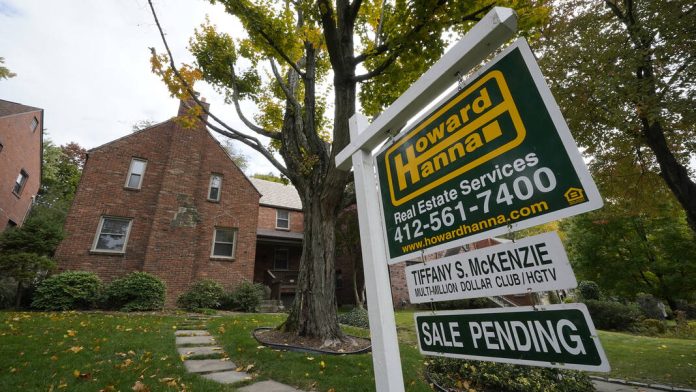
This is a home in Mount Lebanon, Pa., under contract, Oct. 17, 2022. Sales of previously occupied U.S. homes fell in September for the eighth month in a row, though the decline was the most modest yet since the housing market began to cool amid sharply higher mortgage rates. The National Association of Realtors said Thursday, Oct. 20, 2022 that existing home sales fell 1.5% last month from August to a seasonally adjusted annual rate of 4.71 million. (AP Photo/Gene J. Puskar, file)
Sales of previously occupied U.S. homes fell in September for the eighth month in a row, matching the pre-pandemic sales pace from 10 years ago, as house hunters grappled with sharply higher mortgage rates, rising home prices and a still tight supply of properties on the market.
The National Association of Realtors said Thursday that existing home sales fell 1.5% last month from August to a seasonally adjusted annual rate of 4.71 million. That’s slightly higher than what economists were expecting, according to FactSet.
Sales fell 23.8% from September last year, and are now at the slowest annual pace since September 2012, excluding the steep slowdown in sales that occurred in May 2020 near the start of the pandemic.
The national median home price rose 8.4% in September from a year earlier to $384,800.
The housing market has been slowing this year because of rising mortgage rates. The average rate on a 30-year home loan rose to 6.94% this week, the highest rate since April 2002, according to mortgage buyer Freddie Mac. A year earlier, the rate averaged 3.09%.
Higher mortgage rates reduce homebuyers’ purchasing power, resulting in fewer people being able to afford to buy a home.
“Home sales are at a 10-year low condition because of these rising rates,” said Lawrence Yun, NAR’s chief economist.
Mortgage rates have risen sharply along with the 10-year Treasury yield, which has been climbing amid expectations that the Federal Reserve will keep hiking interest rates in its bid to bring down inflation. The 10-year yield reached its highest level since June 2008 this week.
Surging home loan rates don’t just make homes less affordable, they also discourage homeowners who locked in an ultra-low rate the last couple of years from buying a new home. That, in turn, can limit the number of homes that are available for sale.
Some 1.25 million homes were on the market by the end of September, down 2.3% from August and 0.8% versus September last year, NAR said.
On average, homes sold in just 19 days of hitting the market last month, up from 16 days in August. Before the pandemic, homes typically sold more than 30 days after being listed for sale.
At the current sales pace, the level of for-sale properties amounts to a 3.2-month supply, Yun said. That’s unchanged from August. In a more balanced market between buyers and sellers there is a 5- to 6-month supply.




